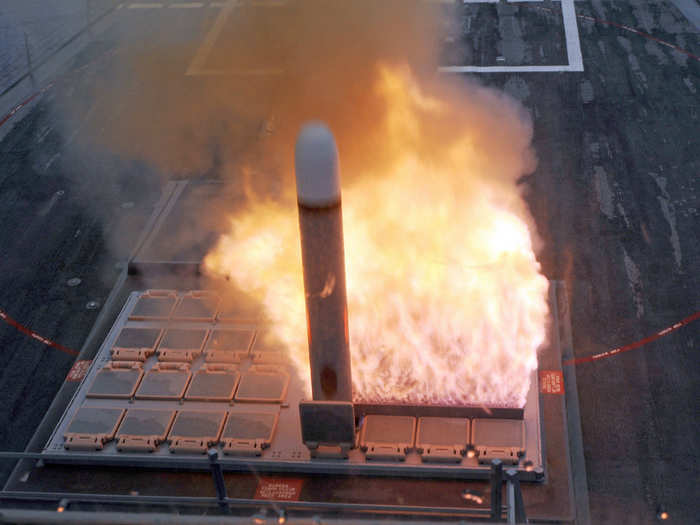
The Tomahawk land attack missile (TLAM) missile has been around since the 70s, and has seen use in Afghanistan, Iraq, and Syria, but a new anti-ship version of the missile with a 1,000 nautical mile range could be deployed onboard Navy ships of all types within a decade.
In February of 2015, the USS Kidd fired a Block IV anti-ship Tomahawk variant that successfully hit a moving target at sea from long range, immediately drawing praise from top naval brass.
“This is potentially a game changing capability for not a lot of cost. It’s a 1000 mile anti-ship cruise missile," said Deputy Secretary of Defense Robert Work after the successful testing. “It can be used by practically by our entire surface and submarine fleet," Work added.
Length: 20 feet long
Weight: 3,000 pounds
Range: 1,000 nautical miles
Speed: subsonic
Navy plans to acquire: 4,000 Tomahawks over five years for $2 billion

http://www.youtube.com/embed/Jgv5ixxgTsQ
Width: 840px
Height: 473px
“[Along with] our surface brothers and sisters, we got to get the long-range missile so we’re not held out by that A2/AD (anti-access/area denial) bubble and we have the stick to hit inside,” said Vice Adm. Joseph Tofalo, commander, Naval Submarine Forces said.

The SM-6 interceptor may be the first missile capable of intercepting both ballistic missiles, which fall from the sky, and cruise missiles, which fly along the surface of earth, sometimes even snaking through mountains.
In the past, these two distinct types of missiles, ballistic and cruise, have required different missiles to stop them, but the SM-6's advanced signal processing and guidance control capabilities make it a useful defense against both types.
Length: 21 feet long
Weight: 3,300 pounds
Range: unspecified
Speed: supersonic
Role in 2017 budget plan: $501 million to acquire 125 SM-6s

http://www.youtube.com/embed/YLZEzQnBhCo
Width: 840px
Height: 473px
“It’s the only missile now out there that has what we call dual-mission capability,” Raytheon program manager Mike Campisi told BreakingDefense.com.
“That allows the combatant commanders to have choice. Instead of having separate boutique missiles for each mission… they can put SM-6s,” Campisi continued.

The LRASM is a precision-guided anti-ship standoff missile with a penetrator and blast fragmentation warhead. The Navy wants the LRASM to replace the harpoon, which has been in service since 1977, and is easily foiled by today's modern defenses.
The LRASM on the other hand, is stealthy due to it's angular shape, making it hard for enemies to detect. Also, in the case of electronic interference, the LRASM has advanced anti-jamming GPS guidance.
Additionally, the LRASM can be fired from ships and planes, like the F/A-18 pictured above.
Length: 14 feet
Weight: 2,100 pounds
Range: more than 200 miles
Speed: high subsonic
Navy plans to acquire: $30 million for the first 10 missiles

http://www.youtube.com/embed/LvHlW1h_0XQ
Width: 840px
Height: 473px
 7 cold destinations in India to escape the summer heat in May
7 cold destinations in India to escape the summer heat in May
 WhatsApp working on feature that will restrict users from taking screenshots of profile pictures: Report
WhatsApp working on feature that will restrict users from taking screenshots of profile pictures: Report
 Having AI knowledge might increase your chances of landing job interviews, UK study finds!
Having AI knowledge might increase your chances of landing job interviews, UK study finds!

Copyright © 2024. Times Internet Limited. All rights reserved.For reprint rights. Times Syndication Service.